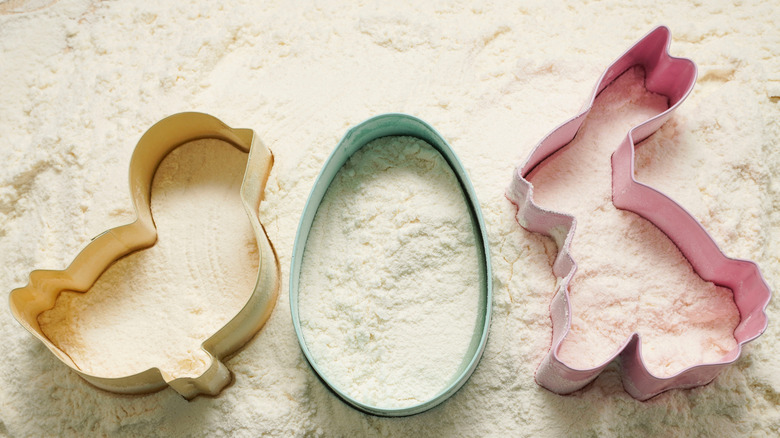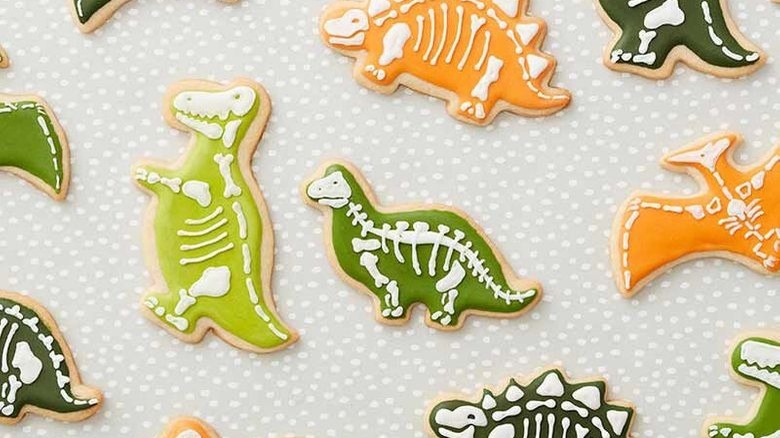What Type Of Cookie Cutter Should You Use For Sugar Cookies?
Why do the sugar cookies that grace the pages of cookbooks and magazines always look so perfect? Seriously, most home bakers would give an arm and a leg, or at the very least, their Smeg mixer, to have just a single batch turn out expertly shaped and golden-hued. Have these confectioners bowed before the altar of the cookie Gods? Or do they simply possess a handful of cookie-concocting secrets that render even the easiest of creations into culinary masterpieces? Inquiring bakers are dying to know.
Being that there is no such thing as a pantheon of cookie deities, one must conclude that these brilliant bakers rely solely on their carefully cultivated know-how. And one of these tricks of the trade will likely take you by surprise. While you may have been expecting something highly complicated with a bunch of multi-syllabic sciency words, you'll be pleased to know that a key ingredient to preparing the perfect sugar cookie is choosing the right cookie cutter. Yes, such a simple thing can make the biggest difference.
The size of your cookie cutter matters
When it comes to selecting the perfect cookie cutter, size really does matter. Expert baker Jerrelle Guy shares with the Kitchn that she prefers using cutters that are three or four inches in width, so she has more space to decorate. But how do you measure a cookie cutter? Typically, you would measure them from their furthest points. If you are measuring a gingerbread man, for instance, you would go from the very top of his little bald head to the bottom of his ginger-scented feet.
And you'll likely want to avoid the overly fussy cutters with intricate designs. In theory, they look lovely and should create a beautiful treat, but in reality, Bon Appetit contends the little detailed doodads will cook faster than the rest of the cookie and burn. There is also a strong possibility that your cookie won't hold the shape of an overly intricate pattern (NBC). If you want your end product to boast a lavish design, you may want to use a cookie stamp or press instead of a complicated cutter. After all, nothing says "amateur attempt" louder than singed dough and broken bits.
Once you have the perfect-sized cookie cutters on hand, test them out with this yummy sugar cookie recipe.
The material of the cookie cutter makes a difference
It turns out that a cookie cutter is only as good as the material used to make it. Per the Kitchn, baking expert Jerrelle Guy likes to use ones constructed of stainless steel as they are stronger and create "cleaner, sharper edges." Georganne Bell, founder of the cookie blog "Lila Loa," says that copper cutters are great if you plan to get a lot of use out of them, as they can cut hundreds and hundreds of cookies without breaking or losing their shape (per NBC News).
Copper cutters might be made of sturdy construction, but Betty Crocker warns that they are more expensive and won't flex, making it hard to remove the dough from the smaller details. The outlet goes on to say that aluminum cutters are affordable, flexible, and capable of handling a certain degree of intricacy, but they lose their shape over time.
Plastic varieties are cheap and flexible, but the edges are dull. Sally McKenney, the founder of Sally's Baking Addiction, tells NBC News that because of this, plastic cutters are the safest for children to operate.
And there you have it. You are one step closer to achieving an artful batch of the absolute best cookies for any occasion. By choosing the right cutter, they will, hopefully, look a lot more like a Norman Rockwell and much less like a Vincent Van Gogh.


